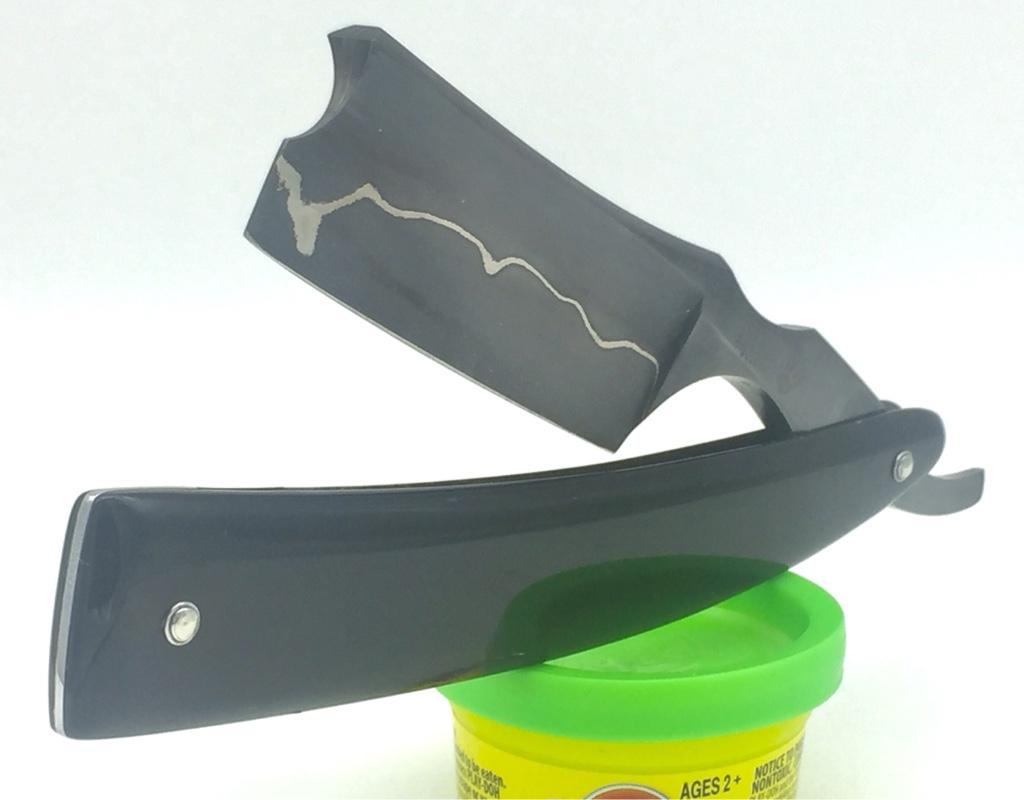Hi All,
I am working on my first horn scales now.

Before I start working on the ox horn, I am trying to get in some practice on Buffalo horn. My father-in-law bought a piece as a present for me and sliced it up on his bandsaw. So above what you see top to bottom - bandsaw face, shiny face as received (it is really glossier than the photo shows due to some label glue still coating the surface), plastic scales (with the white tape), my first finished (?) scales and a 2nd pair that has just been cut to shape with a bandsaw and drilled, but no sanding work yet. And NO the more finished scale didn’t start out the same size as the less finished set!
So from the starting material, I know I should be able to get a much better gloss than I currently have on the finished set. What I did there is machine sanded to shape with 80 and 120, then did a progression of hand sanding with dry W/D up to 1500, then used red rouge (jeweler’s polish) on a felt Dremel wheel.
The 2 thoughts that spring to mind:
1) I made too big a jump from dry 1500 to jeweler’s red rouge.
2) I need to go past jeweler’s rouge to something finer.
My options:
A) W/D - I have this at progressive increments up to about 8000. There is also the question of whether it will work better if I use them wet. I also could slap on some oil if makes sense.
B) Micromesh? Pads - I have these to even higher levels, I think 12000 or 16000 max
C) In addition to red rouge, I have white and green, but my understanding is that red is the finest of these 3
D) Diamond paste - I have 1u, 0.5u, 0.25u and 0.1u
E) For C & D I have the option of felt pads or buffing pads with my dremel
I am open to the idea of buying a polishing compound (Mother’s, Plastic Polis) etc if it makes sense, but I am kind of thinking that I already have enough (or more than enough) options that should be able to get the job done. Main issue at this point is just sorting out which options to try first. But even if you only have a suggestion as to where to focus (too big a jump, or not going fine enough), that will help me figure out which options to focus on.
I did similar experiments with acrylic earlier, I think my conclusion was that I needed to take the grit higher before jumping to jeweler’s rouge. But that was 3 months ago, and I can’t figure out where (or if) I wrote down notes on this. This time I will definitely write it down!
I am working on my first horn scales now.
Before I start working on the ox horn, I am trying to get in some practice on Buffalo horn. My father-in-law bought a piece as a present for me and sliced it up on his bandsaw. So above what you see top to bottom - bandsaw face, shiny face as received (it is really glossier than the photo shows due to some label glue still coating the surface), plastic scales (with the white tape), my first finished (?) scales and a 2nd pair that has just been cut to shape with a bandsaw and drilled, but no sanding work yet. And NO the more finished scale didn’t start out the same size as the less finished set!
So from the starting material, I know I should be able to get a much better gloss than I currently have on the finished set. What I did there is machine sanded to shape with 80 and 120, then did a progression of hand sanding with dry W/D up to 1500, then used red rouge (jeweler’s polish) on a felt Dremel wheel.
The 2 thoughts that spring to mind:
1) I made too big a jump from dry 1500 to jeweler’s red rouge.
2) I need to go past jeweler’s rouge to something finer.
My options:
A) W/D - I have this at progressive increments up to about 8000. There is also the question of whether it will work better if I use them wet. I also could slap on some oil if makes sense.
B) Micromesh? Pads - I have these to even higher levels, I think 12000 or 16000 max
C) In addition to red rouge, I have white and green, but my understanding is that red is the finest of these 3
D) Diamond paste - I have 1u, 0.5u, 0.25u and 0.1u
E) For C & D I have the option of felt pads or buffing pads with my dremel
I am open to the idea of buying a polishing compound (Mother’s, Plastic Polis) etc if it makes sense, but I am kind of thinking that I already have enough (or more than enough) options that should be able to get the job done. Main issue at this point is just sorting out which options to try first. But even if you only have a suggestion as to where to focus (too big a jump, or not going fine enough), that will help me figure out which options to focus on.
I did similar experiments with acrylic earlier, I think my conclusion was that I needed to take the grit higher before jumping to jeweler’s rouge. But that was 3 months ago, and I can’t figure out where (or if) I wrote down notes on this. This time I will definitely write it down!

